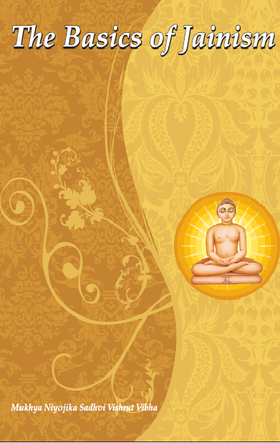The last of the nine fundamentals of Jain philosophy is Moksha (liberation). This is the ultimate destination of a Jiva. It is the state of perfect bliss. According to the book "Illuminator of Jain Tenets", emancipation means the establishment of the soul in its own nature. This is accomplished with the annihilation of all karmas. Liberated souls are known as enlightened and emancipated, and are also called paramatma. These emancipated souls are infinite. They are not subject to reincarnation because the cause of wandering in this world has been totally obliterated. All their karmas are destroyed in two stages: in the first stage, the Ghati karmas are destroyed, resulting in the state of omniscience or kevalgyana. Such a human entity is known as Arhat. The second stage involves the termination of the four Aghati Karmas Naam, Ayushya,Vedniya and Gotra.
The contact of karma with the soul has no beginning, just as every seed is a product of a tree and a tree has its own beginning in another seed and hence, the relation of a seed and a tree has no beginning, similarly the relationship of the karma and the soul is cyclic in nature. When the seed is burnt in fire, it will never regenerate another tree. The vicious cycle of birth and death, i.e. attachment and hatred, are burnt by meditation and penance, to attain 'Moksha'.
As soon as the weight of the karmic particles is released, the soul soars up to the heights of the cosmos. As long as the weight of karmic matter exists, worldly pressures affect the soul. However, as soon as the karmic weight or pressure is destroyed, the soul becomes light and is free from internal and external obstruction in its way to reach its ultimate goal. As the soul gets rid of all the karmas, three events take place simultaneously in one time unit the soul's separation from the body, the soul's upward journey and its arrival at the end of cosmic space. In Jain terminology, this part of space, the end of Lokakasa, is known as the Sidhasila (the abode of liberated souls).
Liberated souls are engrossed in their nature of infinite awareness, infinite enlightenment, infinite energy, and infinite bliss.
The Acaranga sutra explains the liberated soul as "The liberated soul is neither long nor small, nor triangular, nor quadrangular, nor circular. It is not black nor blue, nor red, nor green, nor white. Neither is it heavy nor light, neither cold nor hot, neither harsh nor smooth. It is without body, without resurrection, without contact of matter. It is neither feminine nor masculine nor possesses neuter gender. It has no sound, no colour, no smell, no taste, no touch."
Some philosophers opines that the pleasures of heaven are endless. But according to Jain philosophy, these pleasures also have an end. Though the life span of a heavenly being is immensely longer than that of a worldly being, with the destruction of auspicious karma, one comes back to worldly life. One does not enjoy that happiness forever. Jain philosophy believes in the state of bliss that never ends, which is only possible with liberation or emancipation.
Some philosophers say that one day the world will be left with no living beings it infinite number of Jivas will get liberated. But according to Jain philosophy, though this world consists of an infinite number of Jivas, and once an infinite number of Jiva have been liberated, there will still exist infinite number of Jivas. If you were to ask a student of mathematics, "What would remain if one was subtracted from infinity?", the answer would be "infinity".
Independent Existence:
Each liberated soul has its independent existence. After liberation it does not become a part of a super-soul or Brahma. Just as in a room with a number of lamps, each has its own light and each light is similar to another, but yet has it's own existence; similarly, each emancipated soul is blessed with equal internal attributes and though they are similar, they do not merge into one cosmic soul.
The Integrated trinity of the spiritual path (The path to Moksha):
Right faith, right knowledge and right conduct leads to the path of liberation. Right faith begets right knowledge which in turn begets right conduct. Right faith is the cause while right knowledge and right conduct are the effect. This integrated trinity determines the spiritual path.
Right Faith:
This is the most important factor for achieving our ultimate goal. The person who believes in the right faith understands that his soul resides in the body, but he is not the body, the soul differs from the body. The Soul has consciousness while the body is made of matter.
Right Knowledge:
The second requisite is that right faith must be accompanied by right knowledge. Right faith and right knowledge are contemporaries and related as cause and effect. For instance, though a lamp and its light have an element of togetherness, the light is the effect of the lamp and the lamp is cause of the light. Right knowledge is of five types:
Matigyana: knowledge obtained through the senses and the mind.
Srutagyana: knowledge obtained through reading and hearing scriptures.
Avadhigyana: knowledge obtained through self without the sense of perception, called extrasensory perception knowledge or clairvoyance.
Manahparyavagyana: knowledge of the thoughts of other people, mind-reading knowledge.
Kevalgyana: perfect knowledge or the highest form of knowledge.
Right Conduct:
The third important factor contributing to liberation is right conduct. Mere faith or knowledge is not enough, right conduct is equally essential. Right conduct consists of abstinence from causing injury, falsehood, theft, unchastity and attachment to possessions.
Right faith means firm conviction in the fundamental elements. Right knowledge is the proper knowledge of the elements. Acting in accordance with right faith and right knowledge is defined as right conduct. According to Uttradhyayana Sutra, "There is no right knowledge without right faith, there is no right conduct without right knowledge and there is no perfection without right conduct."
